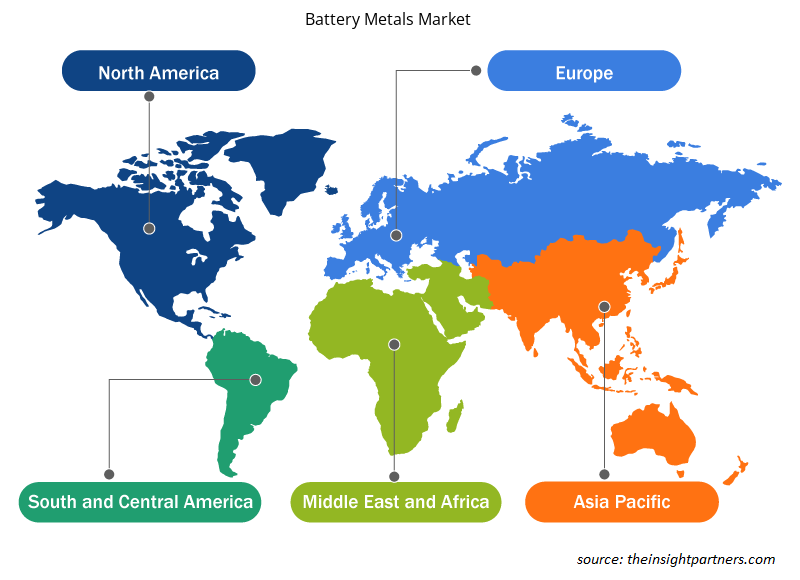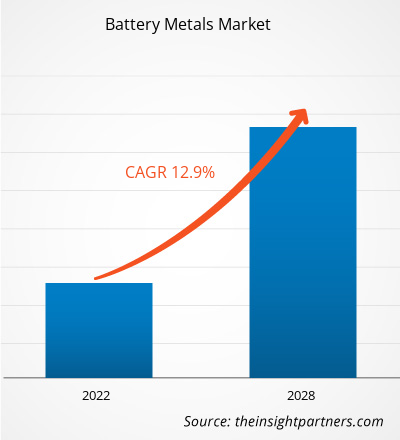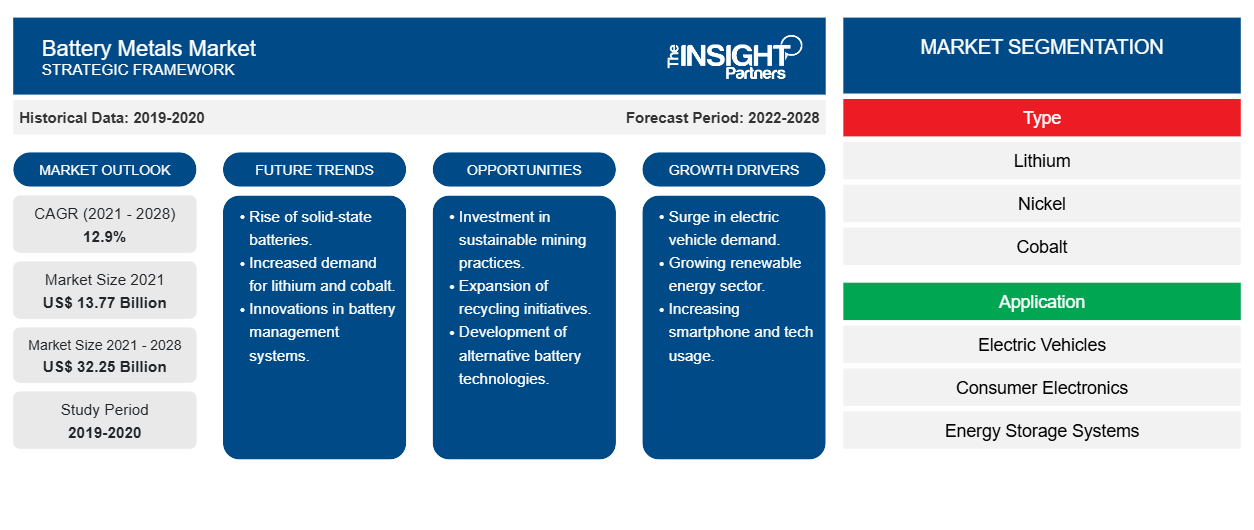[Rapport de recherche] Le marché des métaux pour batteries devrait atteindre 32 251,1 millions USD d'ici 2028, contre 13 770,9 millions USD en 2021 ; il devrait croître à un TCAC de 12,9 % de 2021 à 2028.
Les métaux utilisés dans la fabrication des batteries, comme le lithium, le cobalt, le nickel et le manganèse, sont également utilisés dans les véhicules électriques, l'électronique grand public et d'autres applications.
En 2020, l'Asie-Pacifique détenait la plus grande part de revenus du marché mondial des métaux pour batteries . Divers pays d'Asie-Pacifique connaissent une recrudescence des industries de l'automobile et de l'électronique, ce qui devrait continuer à alimenter la croissance du marché des métaux pour batteries au cours de la période de prévision. En outre, le marché des véhicules électriques dans la région Asie-Pacifique a connu une croissance notable en raison de l'expansion rapide du secteur de l'automobile et de l'électronique.
Personnalisez ce rapport en fonction de vos besoins
Vous bénéficierez d'une personnalisation gratuite de n'importe quel rapport, y compris de certaines parties de ce rapport, d'une analyse au niveau des pays, d'un pack de données Excel, ainsi que de superbes offres et réductions pour les start-ups et les universités.
-
Obtenez les principales tendances clés du marché de ce rapport.Cet échantillon GRATUIT comprendra une analyse de données, allant des tendances du marché aux estimations et prévisions.
La pandémie de COVID-19 a entraîné des perturbations dans la chaîne d'approvisionnement mondiale. De nombreuses industries, telles que l'exploitation minière et les produits chimiques et matériaux, ont été confrontées à des défis sans précédent pour respecter les calendriers de fabrication et de livraison et les ventes de divers produits. Cependant, alors que les économies prévoient de relancer leurs opérations, la demande de métaux pour batteries devrait augmenter à l'échelle mondiale. La reprise des opérations dans l'automobile, l'électronique et d'autres industries a accru le besoin de métaux pour batteries à l'échelle mondiale. L'industrie de l'électronique grand public se développe de manière dynamique avec la hausse des dépenses des consommateurs. L'augmentation de la demande de métaux pour batteries dans diverses applications, telles que les véhicules électriques, l'électronique grand public et les systèmes de stockage d'énergie, ainsi que les investissements importants des principaux fabricants devraient stimuler la croissance du marché des métaux pour batteries dans les années à venir.
Informations sur le marché
Croissance de l'industrie des véhicules électriques
La forte demande mondiale de véhicules électriques soutient la croissance du marché des métaux pour batteries. Les produits à base de métaux pour batteries sont largement utilisés par l'industrie des véhicules électriques en remplacement de l'énergie fossile nécessaire au fonctionnement des véhicules. Dans les zones densément peuplées, les véhicules électriques sont largement utilisés pour réduire la pollution des véhicules, car le nombre de véhicules utilisés est plus élevé dans ces zones. C'est également un facteur important pour assurer la diversification énergétique et réduire les émissions de gaz à effet de serre. Les avantages des véhicules électriques comprennent l'absence d'émissions de gaz d'échappement, le potentiel de réduction des émissions de gaz à effet de serre et une meilleure efficacité que les véhicules à moteur à combustion interne.vehicels are widley used to reduce the vehicles pollution as number of vehicles used are more in such areas. It is also important factor for providing energy diversification and reducing greenhouse gas emission. Benefits of electric vehicles include zero tailpipe emissions, the potential for greenhouse gas emissions reductions, and better efficiency than internal combustion engine vehicles.
Les gouvernements de nombreux pays, dont la Chine, l'Inde et les États-Unis, ont adopté des réglementations pour encourager l'adoption des véhicules électriques. Les véhicules électriques et leur marché connaissent une expansion significative en raison des progrès technologiques continus dans l'électrification des deux/trois-roues, des bus et des camions.three-wheelers, buses, and trucks.
Selon le rapport « Global EV Outlook 2020 » de l'Agence internationale de l'énergie, le parc mondial de véhicules de tourisme électriques a connu une expansion continue en 2019, atteignant 7,2 millions d'unités, soit 40 % de plus qu'en 2018. En raison de tous ces facteurs, la demande de véhicules électriques/hybrides et de véhicules électriques/hybrides rechargeables augmente. Cela stimule à son tour considérablement le marché des métaux pour batteries.EV Outlook 2020' report, there is continuous expansion in global stock of electric passenger vehicles in 2019, reaching 7.2 million units, 40% higher than in 2018. Due to all these factors, the demand for electric vehicles/hybrid and electric vehicles/plug-in hybrid vehicles is growing. This, in turn, is driving the battery metals market substantially.
Informations basées sur le type
Par type, le marché des métaux pour batteries est subdivisé en lithium, nickel, cobalt et autres. Le segment du lithium détenait la plus grande part de marché en 2020. La croissance du segment peut être attribuée à l'application croissante du lithium dans l'industrie des véhicules électriques et de l'électronique en raison de sa propriété de légèreté.subsegmented into lithium, nickel, cobalt, and others. The lithium segment held the largest market share in 2020. The segment's growth can be attributed to the rising application of lithium in the electric vehicles and electronics industry due to its lightweight property.
Informations basées sur les applications
En fonction des applications, le marché des métaux pour batteries est encore segmenté en véhicules électriques, en électronique grand public, en systèmes de stockage d'énergie et autres. Le marché des métaux pour batteries est dominé par le segment des véhicules électriques qui connaît le TCAC le plus élevé au cours de la période de prévision. La demande croissante de véhicules non polluants en raison du changement des normes réglementaires par diverses autorités gouvernementales dans les pays développés et en développement crée un impact énorme sur le marché des métaux pour batteries.
Albemarle Corporation, Umicore, LG Chem, Ganfeng Lithium Co., Ltd., BASF SE, Bolt Metals Corp., Honjo Metal Co., Ltd., Lithium Australia NL, Vale et Metso Outotec figurent parmi les principaux acteurs du marché des métaux pour batteries. Ces acteurs du marché se concentrent sur le développement de produits innovants et de haute qualité pour répondre aux exigences des clients. Albemarle Corporation a annoncé le lancement du Battery Materials Innovation Center (BMIC) sur son site de Kings Mountain, en Caroline du Nord. Le laboratoire a produit des technologies d'anode en métal lithium qui ont augmenté la densité énergétique des batteries en utilisant un laminage avancé de métal lithium pour obtenir des feuilles de lithium de 20 μm d'épaisseur (soit environ un cinquième de l'épaisseur moyenne d'un cheveu humain) ou moins. Jiangsu Ganfeng Power Technology Co., Ltd., une filiale de Ganfeng Lithium Industry, a officiellement emménagé dans une nouvelle usine et a amélioré sa capacité de production grâce au remplacement de ses équipements. Jiangsu Ganfeng propose des systèmes de batteries au lithium pour véhicules industriels comme produit principal pour offrir aux clients des solutions de systèmes d'alimentation à longue durée de vie, à haute endurance, sans entretien et personnalisables et facilite l'itération des véhicules industriels des batteries plomb-acide aux batteries fer-lithium.
Rapports en vedette
- Tendances industrielles progressistes sur le marché mondial des métaux pour batteries pour aider les acteurs à développer des stratégies efficaces à long terme
- Stratégies de croissance des entreprises adoptées par les marchés développés et en développement
- Analyse quantitative du marché mondial des métaux pour batteries de 2019 à 2028
- Estimation de la demande en métaux pour batteries dans diverses industries
- Développements récents pour comprendre le scénario concurrentiel du marché et la demande de véhicules électriques
- Tendances et perspectives du marché associées aux facteurs qui stimulent et freinent la croissance du marché des métaux pour batteries
- Processus de prise de décision en comprenant les stratégies qui sous-tendent l'intérêt commercial à l'égard de la croissance du marché mondial des métaux pour batteries
- Taille du marché des métaux pour batteries à différents nœuds du marché
- Aperçu détaillé et segmentation du marché mondial des métaux pour batteries et de sa dynamique dans l'industrie
- Taille du marché des métaux pour batteries dans diverses régions avec des opportunités de croissance prometteuses
Aperçu régional du marché des métaux pour batteries
Les tendances régionales et les facteurs influençant le marché des métaux pour batteries tout au long de la période de prévision ont été expliqués en détail par les analystes d’Insight Partners. Cette section traite également des segments et de la géographie du marché des métaux pour batteries en Amérique du Nord, en Europe, en Asie-Pacifique, au Moyen-Orient et en Afrique, ainsi qu’en Amérique du Sud et en Amérique centrale.

- Obtenez les données régionales spécifiques au marché des métaux pour batteries
Portée du rapport sur le marché des métaux pour batteries
| Attribut de rapport | Détails |
|---|---|
| Taille du marché en 2021 | 13,77 milliards de dollars américains |
| Taille du marché d'ici 2028 | 32,25 milliards de dollars américains |
| Taux de croissance annuel moyen mondial (2021-2028) | 12,9% |
| Données historiques | 2019-2020 |
| Période de prévision | 2022-2028 |
| Segments couverts |
Par type
|
| Régions et pays couverts |
Amérique du Nord
|
| Leaders du marché et profils d'entreprises clés |
|
Densité des acteurs du marché : comprendre son impact sur la dynamique des entreprises
Le marché des métaux pour batteries connaît une croissance rapide, tirée par la demande croissante des utilisateurs finaux en raison de facteurs tels que l'évolution des préférences des consommateurs, les avancées technologiques et une plus grande sensibilisation aux avantages du produit. À mesure que la demande augmente, les entreprises élargissent leurs offres, innovent pour répondre aux besoins des consommateurs et capitalisent sur les tendances émergentes, ce qui alimente davantage la croissance du marché.
La densité des acteurs du marché fait référence à la répartition des entreprises ou des sociétés opérant sur un marché ou un secteur particulier. Elle indique le nombre de concurrents (acteurs du marché) présents sur un marché donné par rapport à sa taille ou à sa valeur marchande totale.
Les principales entreprises opérant sur le marché des métaux pour batteries sont :
- Société Albemarle
- Boulons en métal
- Ganfeng Lithium Co., Ltd.
- Umicore
- Chimie LG
Avis de non-responsabilité : les sociétés répertoriées ci-dessus ne sont pas classées dans un ordre particulier.

- Obtenez un aperçu des principaux acteurs du marché des métaux pour batteries
Marché des métaux pour batteries, par type
- Lithium
- Nickel
- Cobalt
- Autres
Marché des métaux pour batteries, par application
- Véhicules électriques
- Électronique grand public
- Systèmes de stockage d'énergie
- Autres
Profils d'entreprise
- Société Albemarle
- Umicore
- Chimie LG
- Ganfeng Lithium Co., Ltd.
- BASF SE
- Bolt Metals Corp.
- Honjo Metal Co., Ltd.
- Lithium Australie Pays-Bas
- Vallée
- Metso Outotec
- Éléments américains
- Analyse historique (2 ans), année de base, prévision (7 ans) avec TCAC
- Analyse PEST et SWOT
- Taille du marché Valeur / Volume - Mondial, Régional, Pays
- Industrie et paysage concurrentiel
- Ensemble de données Excel
Rapports récents
Rapports connexes
Témoignages
Raison d'acheter
- Prise de décision éclairée
- Compréhension de la dynamique du marché
- Analyse concurrentielle
- Connaissances clients
- Prévisions de marché
- Atténuation des risques
- Planification stratégique
- Justification des investissements
- Identification des marchés émergents
- Amélioration des stratégies marketing
- Amélioration de l'efficacité opérationnelle
- Alignement sur les tendances réglementaires























 Obtenez un échantillon gratuit pour - Marché des métaux pour batteries
Obtenez un échantillon gratuit pour - Marché des métaux pour batteries